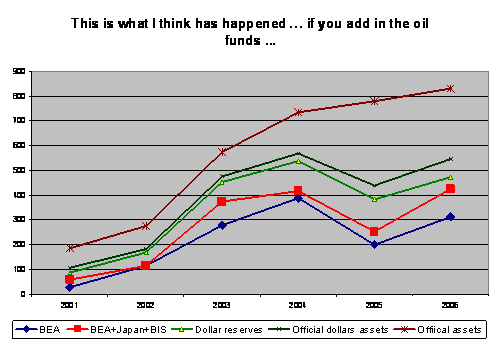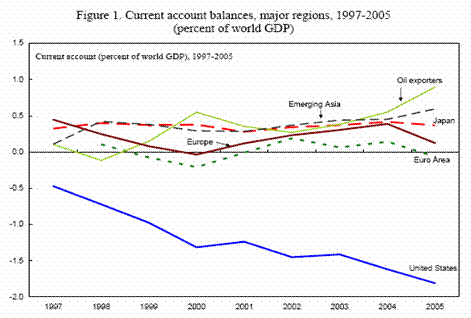The Allied Social Sciences Association (incorporating the AEA, the Econometric Society, the International Economics and Finance Society and many other groups) meetings took place in Chicago this last weekend. I wasn’t able to go to that many sessions, but I did attend a few related to international issues.
One theme that ran through several was questions surrounding the origins of the current pattern of global imbalances. In the National Association of Business Economics (NABE) panel on international capital flows, Emanuel Farhi presented a paper (with R. Caballero and P.-O. Gourinchas) arguing that the underdevelopment of financial markets — essentially the inability to produce assets — in East Asia combined with rapid growth in the region is driving the pattern of lending to the developed regions. In one sense, this is an argument based on comparative advantage. The US and Europe are relatively good producing financial assets while East Asia is relatively good at producing goods. The model results are driven by a parameter (delta) that defines how well financial systems are at making assets; as long as East Asia’s “delta” is smaller than that of the developed economies, the current patterns will persist. In my view, the model is a very simple way of formalizing the Bernanke saving glut hypothesis. But the timing (the model is flexible enough to encompass many interpretations of delta) is a little mysterious, given that the imbalances have ballooned post 1998, and this asymmetry in delta has presumably been in place all along. (Another paper, by Enrique Mendoza et al., recently presented at the IMF Annual Research Conference tackled this same issue.)
Brad Setser, characterized by his discussant as “the master of reserves tracking, argued that U.S. data is becoming ever less useful for tracking the accumulation of dollar assets by central banks. In his presentation (firewalled version here), he argues that U.S. BEA estimates now understate foreign official accumulation by about $200 billion, a not inconsequential figure. This point is highlighted by the difference between the blue line (official BEA estimate) and the black line (Setser’s estimate).

Figure 1: Estimates of official dollar asset holdings. Source: Setser (2006).
Setser’s presentation sparked a spirited discussion of whether the global saving glut view of the world — where private agents are undertaking the asset trades — really explains the current pattern of imbalances, since so much of the capital flows are being driven by the official sector.
In an AEA panel on current account imbalances, a paper by Phillip Lane and Gian Maria Milesi-Ferretti demonstrated that, even though Europe is running a small current account deficit (see Figure 2), its role in the global adjustment process could be potentially quite large.

Figure 2: Source: Lane and Milesi-Ferretti (2006).
The reason is quite simple: because the U.S. holds a large amount of its foreign assets in the euro area, while its liabilities are in dollars, this means that how the U.S. current account imbalance is adjusted (by exchange rate versus growth differentials changes) in response to differing shocks has big implications for wealth and portfolio adjustments. The less flexibility in East Asian exchange rates against the dollar, the bigger the impact on Europe. Although there has been lots of informal discussion to this effect, this is one of the first to try to systematically model the issue. (My discussion of this paper at the IMF conference is here).
In the same panel, Pierre-Olivier Gourinchas made a presentation entitled (World Bankers, with H. Rey and C. Lopez) which traced out the path of assets and liabilities of the UK from 1950 onward, and contrasts it with that of the United States. The reason for doing this is to shed light on the question of how durable the “exorbitant privilege” the US enjoys is. The “exorbitant privilege” is, in the Gourinchas-Rey lexicon, the phenomenon wherein the rate of return foreigners receive on their assets in the U.S. is systematically less than that received by U.S. investors on their assets abroad, across asset classes (bonds, stocks, direct investment, bank loans). He concludes:
- 100 years ago, the U.K. was in the position of the U.S. now. It
supplied liquidity to the rest of the world, and probably enjoyed
the associated intermediation rents.
- These rents are now disappearing. The large positive valuation
effects in the U.K. come from the leverage of relatively small
return differences through extremely large gross asset and
liability positions.
- These findings provide a window on a future where the U.S.
dollar would lose its status as international currency.
Self-promotion moment: here is a paper which discusses the determinants of reserve currency status.
On a different (trade-related) note, former IMF Deputy Managing Director Anne Krueger gave the Society of Government Economists Presidential Address. Her presentation, entitled “Multilateral Organizations and the International Economy”, was a wide ranging survey of the past and prospects for multilateralism. Since there’s no online version of the paper, and my transcribing abilities are limited, I’ll just mention the main points I gathered, with the caveat that I may have missed some subtleties.
She observed that the multilateral system faces some serious challenges because, in some sense it has been taken for granted. Three major problems are identified.
- The reliance on preferential trading arrangements (PTAs), which might possibly cause more trade diversion than creation, but more importantly may be diverting attention and resources from the more important task of implementing multilateral trade barrier reduction.
- Capital flows do not fall under any system of nondiscrimination with regard to source and destination. Combined with the proliferation of PTAs, this may lead to discrimination in the treatment of capital flows.
- Countries are favoring their short term self interest over their longer term interest in a well-working multilateral system. The concrete example she has in mind (I think) is the realignment of voting rights within the IMF.
I discussed the potentially anti-trade aspects of so-called “free trade agreements” in this post.
Finally, diverging from international economics, I think all economists should read the paper by George Akerlof (cited in Saturday’s NYT), entitled “The Missing Motivation in Macroeconomics”.
Technorati Tags: American Economic Association,
dollar,
trade deficit,
global saving glut
valuation effects,
exorbitant privilege,
preferential trading arrangement,
foreign exchange reserves
Menzie — thanks for the plug! One clarifying point. Of the $200b gap, maybe $100b likely reflects undercounting of actual central bank/ oil fund purchases as a result of “custodial bias” and the other $100b reflects dollars central banks have put on deposit in the international banking system/ their own banks (Korea and China have both done swaps with their local banks). The banks then use the dollars to buy US securities — or to make loans to say private equity shops or hedge funds or others. That kind of intermingling raises some complex issues — the actual purchases is private and private investors are picking what to buy. but without the dollar on deposit from the central bank, they wouldn’t have as much money (liquidity) to play with. And the cetrnal bank retains the currency risk.
One session not mentioned was a big AEA session with big guns on the dollar and saving. Chaired by Dominick Salvatore, those arguing for fixed rates (the big issue was dollar and Chinese yuan/rmb) were Robert Mundell (who says 7.5 to 1 looks good, let it go to there and then fix) and
Ronald McKinnon. Pushing for a free float and major dollar devaluation was Martin Feldstein, who also said that the US needs more savings, everybody says the US savings rate must go up. More intermediate were Kenneth Rogoff and Michael Mussa, both of whom have had policy experience at the IMF, which tends to make people a bit more cautious about going off to one extreme or the other.
Barkley,
I always laugh when I hear people whining about a lack of savings. That is the easiest thing in the world to correct; just get congress to stop penalizing savings. And if you really want to ramp them up pass laws that exempt savings from taxes.
Congress has proven the old adage “if you want less of something tax it.”
Thanks to Brad Setser for the clarification.Barkley Rosser: Yes, I couldn’t get to that one. Of course, once one is familiar with these individuals views, there is some predictability to the session. I think last year’s roundtable was pretty good, in particular Jeffrey Frankel’s discussion of the twin deficits. I think the points he raised are still relevant.
DickF: Over the past two decades, we have been devoting ever more subsidies to household saving, with little effect on total household saving; in fact HH saving has decreased. But I do agree that decreasing the tax rate on saving would likely raise saving (although one cannot ignore the offsetting forces of income and substitution effects which makes that adage case-specific). Removing the deductibility of mortgage payments would be one way to increas the tax rate on borrowing, i.e., on dis-saving.
Thanks Menzi. I do agree with you concerning savings, but like tax cuts not all savings are equal. One of our biggest problems (kin to your comments in another thread on trade agreements) is that when savings are targeted by congress this actually shifts the distribution of resources rather than increasing savings, and often leads to reduced savings because of the costs involved with such reallocations to take advantage of the tax breaks.
As is usually the case the best approach to savings is to remove the obstacles and allow the market to find the optimum.
Interesting post Menzie with a lot of top class references.
I especially noted the IMF paper on global imbalances and Europe. It looks very solid but I am not sure I agree that structural reforms in Europe would be enough to decidedly make Europe contribute the re-balancing process. I believe there is a big misconcetion looming here that Europe can just ‘become more like the US.’
More generally, I am also a firm believer that demographics at least to some extent drive international capital flows and following this some countries in Europe are just not geared (given their rapidly ageing populations) to contribute to a re-balancing process. Germany is a good example here and Italy is as well.
But then again in a more general global imbalance perspective I am also sure that Setser’s point about how ‘relative prices matter’ vis-a-vis the East Asian and Petroexporters’ dollar pegs is important.
Thank you for the summary of current thinking on the US trade deficit. I also agree with your comment to DickF on household savings that there is too much reward for borrowing leading to an expectation and dependence on home appreciation. However the reward for saving is less apparent because it’s deferred until retirement.
Would placing a cap on mortgage payment deduction and giving a capped deduction on ordinary interest give substantial incentive to affect the trade imbalance?